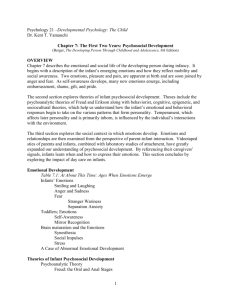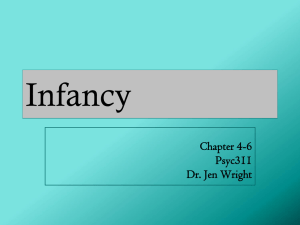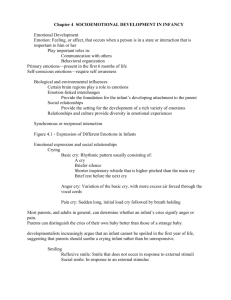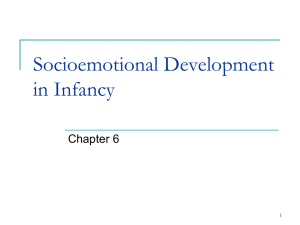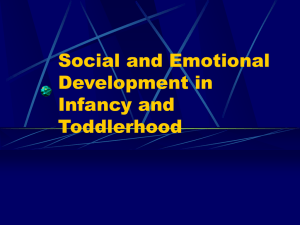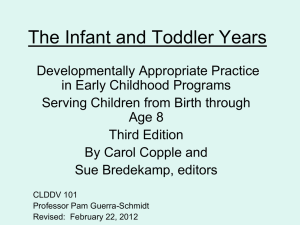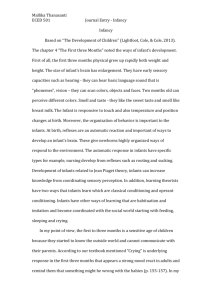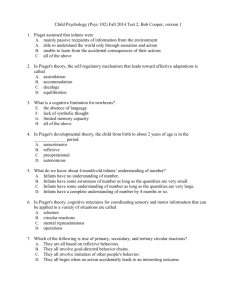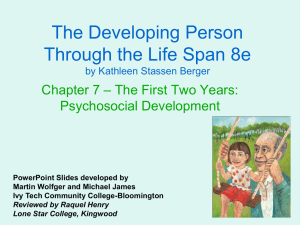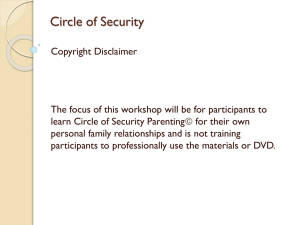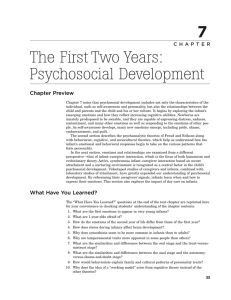Emotion - FacultyWeb Support Center
advertisement
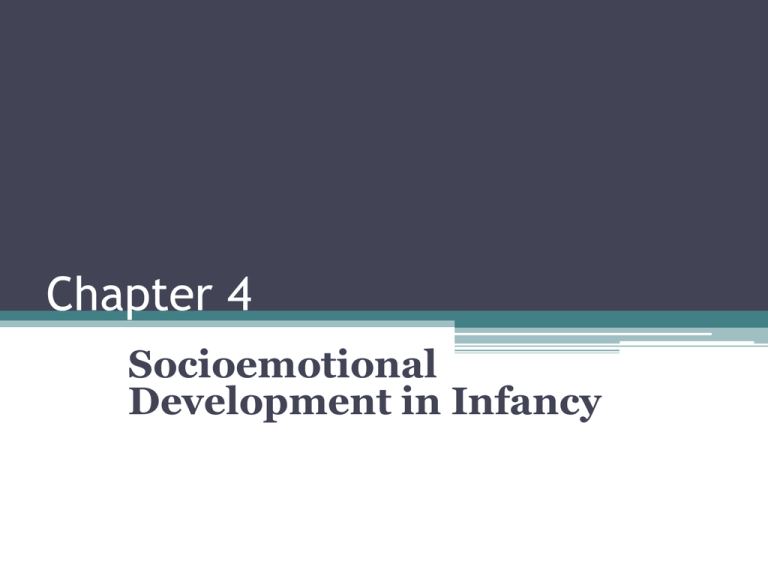
Chapter 4 Socioemotional Development in Infancy What Are Emotions? • Emotion -- feeling, or affect, that occurs when a person is in a state or an interaction that is important to him or her, especially to his or her well-being • Emotions involve an individual’s communication with the world • In infancy, it is the communication aspect that is at the forefront of emotion (Campos, 2009) Biological and Environmental Influences • Emotions are influenced both by biological foundations and by a person's experience • Facial expressions of basic emotions such as happiness, surprise, anger, and fear are the same across cultures ▫ Display rules—when, where, and how emotions should be expressed—are not culturally universal (Shiraev & Levy, 2010) Early Emotions • In the first six months, infants may express surprise, interest, joy, anger, sadness, fear, and disgust • Other emotions appear in the second half of the first year and by the second year ▫ jealousy, empathy, embarrassment, pride, shame, and guilt these have been called self-conscious emotions or other-conscious emotions ▫ Example: Don’t cry over spilled milk?, glass for Mommy, his toy is better – always! (Lewis, 2007; Saarni & others, 2006) Emotional Expressions and Relationships • Emotional expressions -- infants’ first relationships • Infants communicate emotions and this enables coordinated interactions with their caregivers • Parents change their emotional expressions in response to infants’ emotional expressions • Infants also modify their emotional expressions in response to their parents’ emotional expressions ▫ “Synchrony” Crying • Crying -- most important mechanism newborns have for communicating • Babies have at least three types of cries: ▫ basic cry some infancy experts believe that hunger is one of the conditions that incite the basic cry ▫ anger cry ▫ pain cry the pain cry may be stimulated by physical pain or by any high-intensity stimulus Should Parents Respond to an Infant’s Cries? • Many developmentalists recommend that parents soothe a crying infant, especially in the first year • This reaction should help infants develop a sense of trust and secure attachment to the caregiver Smiles • Two types of smiling can be distinguished in infants: ▫ Reflexive smile -- does not occur in response to external stimuli and appears during the first month after birth, usually during sleep ▫ Social smile -- occurs in response to an external stimulus Social smiling often occurs in response to a caregiver’s voice (Campos, 2005) Fear • Fear -- one of a baby’s earliest emotions ▫ first appears at about 6 months and peaks at about 18 months ▫ abused and neglected infants can show fear as early as 3 months ▫ stranger anxiety -- most frequent expression of an infant’s fear usually emerges gradually depends on the social context and the characteristics of the stranger ▫ Examples: Quivering lip, Santa Claus/Easter Bunny (Campos, 2005; Emde, Gaensbauer, & Harmon, 1976) Frequency of Stranger Anxiety • Less stranger anxiety when they are in familiar settings • When infants feel secure, they are less likely to show stranger anxiety • Less fearful of child strangers than adult strangers • Less fearful of friendly, outgoing, smiling strangers than of passive, unsmiling strangers • Separation protest -- crying when the caregiver leaves ▫ Example: Babysitters, daycare (Bretherton, Stolberg, & Kreye, 1981) Social Referencing • Social referencing -- reading emotional cues in others to help determine how to act in a particular situation ▫ Examples: Falling? Thunder? ▫ helps infants to interpret ambiguous situations more accurately ▫ by the end of the first year, a parent’s facial expression influences exploration of an unfamiliar environment ▫ social referencing improves in the second year of life Emotional Regulation and Coping • During the first year of life, infant develops ability to minimize the intensity and duration of emotional reactions • From early in infancy, babies may put their thumbs in their mouths to self-soothe • In their second year, they may say things to themselves to help self-soothe (Eisenberg, Spinrad, & Smith, 2004) Emotional Regulation and Coping • Caregivers’ actions influence the infant’s neurobiological regulation of emotions ▫ Good strategy to soothe an infant before the infant gets into an intense, agitated, uncontrolled state • Later in infancy, infants sometimes redirect their attention or distract themselves in order to reduce their arousal (Laible & Thompson, 2007; de Haan & Gunnar, 2009; Thompson, 2006; Grolnick, Bridges, & Connell, 1996) Contextual Adaptation • Contexts can influence emotional regulation • Often affected by fatigue, hunger, time of day, which people are around them, and where they are • Must learn to adapt to different contexts ▫ Example: no birthday party (Thompson, 2010) Describing and Classifying Temperament • Researchers have described and classified the temperament of individuals in three different ways “Individual differences in emotion, motor, and attentional reactivity and self-regulation” (Rothart & Bates, 1998) • Chess and Thomas’ Classification ▫ Easy, difficult, and slow-to-warm-up child • Kagan’s Behavioral Inhibition ▫ Inhibition to the unfamiliar • Effortful Control (Self-Regulation) Effortful Control (Self-Regulation) • Effortful control (self-regulation) is an important dimension of temperament ▫ Infants high on effortful control show an ability to keep their arousal from getting too high and have strategies for soothing themselves ▫ Infants low on effortful control are often unable to control their arousal; they are easily agitated and become intensely emotional (Bates, 2008) Biological Foundations and Influences • Physiological characteristics have been linked with different temperaments (nature) • Inhibited temperament is associated with a unique physiological pattern ▫ high and stable heart rate ▫ high level of the hormone cortisol ▫ high activity in the right frontal lobe of the brain (Kagan, 2010) Personality Development • Personality -- the enduring personal characteristics of individuals ▫ Emotions and temperament form key aspects • Trust ▫ Erikson -- first year of life is characterized by the trust versus mistrust stage/crisis Self-Recognition • Infants begin to develop a rudimentary form of self-recognition -- being attentive and positive toward one’s image in a mirror as early as 3 months • A more complete index of self-recognition -- the ability to recognize one’s physical features ▫ emerges in the second year Examples: Hats, Rouge, floor image (Pipp, Fischer, & Jennings, 1987; Thompson, 2006) Independence • Erikson (1968) stressed that independence is an important issue in the second year of life ▫ Erikson’s second stage of development is identified as “autonomy versus shame and doubt” ▫ autonomy builds as the infant’s mental and motor abilities develop ▫ when caregivers are impatient and do for toddlers what they are capable of doing themselves, shame and doubt develop Attachment • Attachment -- a close emotional bond between two people • Freud theorized that infants become attached to the person or object that provides oral satisfaction • Harry Harlow’s classic study ▫ Attachment, fear, exploration • Four phases based on Bowlby’s conceptualization of attachment ▫ ▫ ▫ ▫ Phase 1: From birth to 2 months Phase 2: From 2 to 7 months Phase 3: From 7 to 24 months Phase 4: From 24 months on Theories of Attachment • Bowlby -- belief in an internal working model of attachment, keep the caregiver near ▫ a simple mental model of the caregiver, their relationship, and the self as deserving of nurturant care • Mary Ainsworth (1979) created the Strange Situation ▫ the degree to which the caregiver’s presence provides the infant with security and confidence (Thompson, 2006; Ainsworth, 1979) Individual Differences in Attachment • Based on how babies respond in the Strange Situation ▫ securely attached babies use the caregiver as a secure base ▫ insecure avoidant babies show insecurity by avoiding the mother ▫ insecure resistant babies often cling to the caregiver and then resist, fighting against the closeness ▫ insecure disorganized babies -- disorganized and disoriented Criticisms of Attachment Theory • Kagan and others believe that too much emphasis has been placed on the attachment bond in infancy • Jerome Kagan sees infants as highly resilient and adaptive ▫ they are equipped to stay on a positive developmental course • Attachment theory ignores the diversity of socializing agents and contexts in an infant’s world (Kagan, 1987, 2002) Reciprocal Socialization • Socialization that is bidirectional ▫ children socialize parents just as parents socialize children • Scaffolding -- timing interactions so that the infant experiences turn-taking with the parents ▫ scaffolding involves parental behavior that supports children’s efforts ▫ caregivers provide a positive, reciprocal framework for interaction Maternal and Paternal Caregiving • Mothers spend considerably more time in caregiving with infants and children than do fathers ▫ Mothers are more likely to have managerial role • Fathers have the ability to act sensitively and responsively with their infants • Typical father behaves differently toward an infant than the typical mother • Father’s presence in a child’s life is beneficial ▫ Leads to more success in school (Lamb, 2010; Parke & Buriel, 2006) Parental Leave • More young children are in child care than at any other time in U.S. history • U.S. adults tend not to receive paid leave to care for their young children • The United States allows up to 12 weeks of unpaid leave for parents who are caring for a newborn • The European Union has mandated a 14-week maternity leave Variations in Child Care • Factors that influence the effects of child care ▫ the age of the child ▫ the type of child care ▫ the quality of the program Types of Child Care • Large centers with elaborate facilities • Private homes • Commercial operations or nonprofit centers run by churches, civic groups, and employers • Child care providers vary ▫ Professionals ▫ Untrained adults who want to earn extra money Quality of Care Makes a Difference • Poor-quality child care is more likely for families with few resources (psychological, social, and economic) • Extensive child care was harmful to low-income children only when the care was of low quality • High-quality care was linked with fewer internalizing problems (e.g., anxiety) and externalizing problems (e.g., aggressive and destructive behaviors) Strategies to Follow in Choosing Child Care • Recognize that the quality of your parenting is a key factor in your child’s development • Make decisions that will improve the likelihood you will be good parents • Monitor your child’s development • Take some time to find the best child care (Kathleen McCartney, 2003)
